
Sento
Encyclopedia
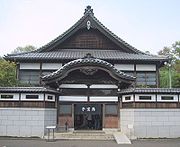
Japan
Japan is an island nation in East Asia. Located in the Pacific Ocean, it lies to the east of the Sea of Japan, China, North Korea, South Korea and Russia, stretching from the Sea of Okhotsk in the north to the East China Sea and Taiwan in the south...
ese communal bath house
Public bathing
Public baths originated from a communal need for cleanliness. The term public may confuse some people, as some types of public baths are restricted depending on membership, gender, religious affiliation, or other reasons. As societies have changed, public baths have been replaced as private bathing...
where customers pay for entrance. Traditionally these bath houses have been quite utilitarian, with one large room separating the sexes by a tall barrier, and on both sides, usually a minimum of lined up faucet
Tap (valve)
A tap is a valve controlling release of liquids or gas. In the British Isles and most of the Commonwealth, the word is used for any everyday type of valve, particularly the fittings that control water supply to bathtubs and sinks. In the U.S., the term "tap" is more often used for beer taps,...
s and a single large bath for the already washed bathers to sit in among others. Since the second half of the 20th century, these communal bath houses have been decreasing in numbers as more and more Japanese residences now have baths. Some Japanese find social importance in going to public baths, out of the theory that physical proximity/intimacy brings emotional intimacy, which is termed skinship in Japanese. Others go to a sentō because they live in a small housing facility without a private bath or to enjoy bathing in a spacious room and to relax in saunas or jet baths that often accompany new or renovated sentōs.
Another type of Japanese public bath is onsen
Onsen
An is a term for hot springs in the Japanese language, though the term is often used to describe the bathing facilities and inns around the hot springs. As a volcanically active country, Japan has thousands of onsen scattered along its length and breadth...
, which uses hot water from a natural hot spring. They are not exclusive: A sentō can be called an onsen if it derives its bath water from naturally heated hot springs. A legal definition exists that can classify a public bathing facility as sentō.
Layout and architectural features
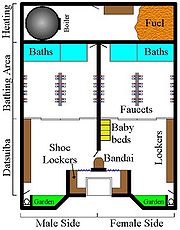
Entrance area
There are many different looks for a Japanese sentō, or public bath. Most traditional sentō, however, are very similar to the layout shown on the right. The entrance from the outside looks somewhat similar to a temple, with a Japanese curtain (暖簾, norenNoren
Noren are traditional Japanese fabric dividers, hung between rooms, on walls, in doorways, or in windows. They usually have one or more vertical slits cut from the bottom to nearly the top of the fabric, allowing for easier passage or viewing...
) across the entrance. The curtain is usually blue and shows the kanji
Kanji
Kanji are the adopted logographic Chinese characters hanzi that are used in the modern Japanese writing system along with hiragana , katakana , Indo Arabic numerals, and the occasional use of the Latin alphabet...
湯 (yu, lit. hot water) or the corresponding hiragana
Hiragana
is a Japanese syllabary, one basic component of the Japanese writing system, along with katakana, kanji, and the Latin alphabet . Hiragana and katakana are both kana systems, in which each character represents one mora...
ゆ. After the entrance there is an area with shoe lockers, followed by two long curtains or door, one on each side. These lead to the datsuijo (脱衣場, changing room), also known as datsuiba for the men and women respectively. The men's and the women's side are very similar and differ only slightly.
Changing room

Inside, between the entrances is the bandai (番台), where the attendant sits. The bandai is a rectangular or horseshoe-shaped platform with a railing, usually around 1.5 to 1.8 m high. Above the bandai is usually a large clock. Immediately in front of the bandai is usually a utility door, to be used by the attendants only. The dressing room is approximately 10 m by 10 m square, sometimes partly covered with tatami sheets
Tatami
A is a type of mat used as a flooring material in traditional Japanese-style rooms. Traditionally made of rice straw to form the core , with a covering of woven soft rush straw, tatami are made in standard sizes, with the length exactly twice the width...
and contains the lockers for the clothes. Often, there is a large shelf storing equipment for regular customers.
The ceiling is very high, at 3 to 4 m. The separating wall between the men's and the women's side is about 2 m high. The dressing room also often has access to a very small Japanese garden
Garden
A garden is a planned space, usually outdoors, set aside for the display, cultivation, and enjoyment of plants and other forms of nature. The garden can incorporate both natural and man-made materials. The most common form today is known as a residential garden, but the term garden has...
with a pond, and a Japanese-style toilet. There are a number of tables and chairs, including some coin-operated massage chairs. Usually there is also a scale to measure weight, and sometimes height. In some very old sentō, this scale may use the traditional Japanese measure monme (匁, 1 monme = 3.75 g) and kan (1 kan = 1000 monme = 3.75 kg). Similarly, in old sentō the height scale may go only to 180 cm. Local business often advertises in the sentō. The women's side usually has some baby beds, and may have more mirrors. The decoration and the advertising
Advertising
Advertising is a form of communication used to persuade an audience to take some action with respect to products, ideas, or services. Most commonly, the desired result is to drive consumer behavior with respect to a commercial offering, although political and ideological advertising is also common...
is often gender-specific on the different sides. There's usually a refreshment cooler here where customers can self-serve and pay the attendant. Milk drinks are traditional favorites and sometimes there's ice cream
Ice cream
Ice cream is a frozen dessert usually made from dairy products, such as milk and cream, and often combined with fruits or other ingredients and flavours. Most varieties contain sugar, although some are made with other sweeteners...
.
Bathing area
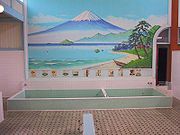
Okinawa Prefecture
is one of Japan's southern prefectures. It consists of hundreds of the Ryukyu Islands in a chain over long, which extends southwest from Kyūshū to Taiwan. Okinawa's capital, Naha, is located in the southern part of Okinawa Island...
region, as the weather there is usually already hot, and there is no need to keep the hot air in the bath. Sentō in Okinawa usually have no separation between the changing room and the bathing area or only a small wall with an opening to pass through.
The bathing area is usually tiled. Near the entrance area is a supply of small stools and buckets. There are a number of washing stations at the wall and sometimes in the middle of the room, each with usually two faucets (karan, カラン, after the Dutch word
Dutch language
Dutch is a West Germanic language and the native language of the majority of the population of the Netherlands, Belgium, and Suriname, the three member states of the Dutch Language Union. Most speakers live in the European Union, where it is a first language for about 23 million and a second...
kraan for faucet), one for hot water and one for cold water, and a shower head.
At the end of the room are the bathtub
Bathtub
A bath , bathtub , or tub is a large container for holding water in which a person may bathe . Most modern bathtubs are made of acrylic or fiberglass, but alternatives are available in enamel over steel or cast iron, and occasionally waterproof finished wood...
s, usually at least two or three with different water temperatures, and maybe a 'denki buro' (電気風呂, electric bath). In the Osaka
Osaka
is a city in the Kansai region of Japan's main island of Honshu, a designated city under the Local Autonomy Law, the capital city of Osaka Prefecture and also the biggest part of Keihanshin area, which is represented by three major cities of Japan, Kyoto, Osaka and Kobe...
and Kansai area the bathtubs are more often found in the center of the room, whereas in Tokyo they are usually at the end of the room. The separating wall between the men and the women side is also about 2 m high. The ceiling may be 4 m high, with large windows in the top. On rare occasions the separating wall also has a small hole. This was used to pass soap. At the wall on the far end of the room is usually a large ceramic tile mural or painting for decoration. Most often this is Mount Fuji
Mount Fuji
is the highest mountain in Japan at . An active stratovolcano that last erupted in 1707–08, Mount Fuji lies about south-west of Tokyo, and can be seen from there on a clear day. Mount Fuji's exceptionally symmetrical cone is a well-known symbol of Japan and it is frequently depicted in art and...
as seen in the picture to the right, but it may be a general Japanese landscape, a (faux) European landscape, a river or ocean scene. On rarer occasions it may also show a group of warriors or a female nude on the male side. Playing children or a female beauty often decorate the women's side.
Boiler room
Behind the bathing area is the boiler room (釜場, kamaba), where the water is heated. This may use oil or electricity, or any other type of fuel such as wood chippings. The tall chimneys of the boilers are often used to locate the sentō from far away. After the war Tokyo often had power outages when all bath house owners turned on the electric water heating at the same time.Sauna
Many modern sentō have a saunaSauna
A sauna is a small room or house designed as a place to experience dry or wet heat sessions, or an establishment with one or more of these and auxiliary facilities....
with a bathtub of cold water just outside it for cooling off afterwards. It should be noted that you are expected to pay an extra fee to use the sauna, and you will often receive a simple wristband to signify your payment of the extra fee.
Etiquette
This section describes the basic procedure to use a sentō. While many Japanese are understanding if foreigners make cultural mistakes, the public bath is an area where the uninitiated can seriously offend the regulars.Equipment
Taking a bath at a public sentō requires at a bare minimum a small towelTowel
A towel is a piece of absorbent fabric or paper used for drying or wiping. It draws moisture through direct contact, often using a blotting or a rubbing motion. Common household textile towels are made from cotton, rayon, bamboo, nonwoven fibers or a few other materials.-Types of towels:* A bath...
and some soap
Soap
In chemistry, soap is a salt of a fatty acid.IUPAC. "" Compendium of Chemical Terminology, 2nd ed. . Compiled by A. D. McNaught and A. Wilkinson. Blackwell Scientific Publications, Oxford . XML on-line corrected version: created by M. Nic, J. Jirat, B. Kosata; updates compiled by A. Jenkins. ISBN...
/shampoo
Shampoo
Shampoo is a hair care product used for the removal of oils, dirt, skin particles, dandruff, environmental pollutants and other contaminant particles that gradually build up in hair...
. Attendants usually sell these items for 100-200 yen. Many people bring two towels; a handtowel for drying and a handtowel or washcloth for washing. A nylon scrubbing cloth or scrub brush with liquid soap is normally used for washing. Other body hygiene products may include a pumice
Pumice
Pumice is a textural term for a volcanic rock that is a solidified frothy lava typically created when super-heated, highly pressurized rock is violently ejected from a volcano. It can be formed when lava and water are mixed. This unusual formation is due to the simultaneous actions of rapid...
stone, toothbrush, toothpaste, shaving equipment, combs, shower caps, pomade, make up
Cosmetics
Cosmetics are substances used to enhance the appearance or odor of the human body. Cosmetics include skin-care creams, lotions, powders, perfumes, lipsticks, fingernail and toe nail polish, eye and facial makeup, towelettes, permanent waves, colored contact lenses, hair colors, hair sprays and...
products, powder, creams, etc. Some regular customers store their bucket of bathing equipment on open shelves in the dressing room.
Entrance and undressing
In Japan it is customary to remove one's shoes when entering a private home. Similarly shoes are removed before entering the bathing area in a sentō. They are kept in a shoe locker. The locker is usually available free of charge. Afterwards bathers go through one of the two doors depending on their gender. The men's door usually has a bluish color and the kanjiKanji
Kanji are the adopted logographic Chinese characters hanzi that are used in the modern Japanese writing system along with hiragana , katakana , Indo Arabic numerals, and the occasional use of the Latin alphabet...
for man (男, otoko), and the women's door usually has a reddish color and the kanji for woman (女, onna). The fee is set at 450 yen
Japanese yen
The is the official currency of Japan. It is the third most traded currency in the foreign exchange market after the United States dollar and the euro. It is also widely used as a reserve currency after the U.S. dollar, the euro and the pound sterling...
for all sentō in Tokyo. The attendant usually provides at extra cost a variety of bath products including towel, soap, shampoo, razor, and comb. Ice cream or juice from the freezer can also be paid for here.
There are usually free lockers with keys (that may be worn on the wrist into the baths) or large baskets provided to put personal effects.
Bathing area
At onsenOnsen
An is a term for hot springs in the Japanese language, though the term is often used to describe the bathing facilities and inns around the hot springs. As a volcanically active country, Japan has thousands of onsen scattered along its length and breadth...
, or hot springs, the water contains minerals, and many people do not rinse off the water from the skin, to increase exposure to the minerals. In a regular sentō, people usually rinse off at the faucets.
Etiquette
As mentioned above, the Japanese public bath is one area where the uninitiated can upset regular customers by not following correct bathing etiquette designed to respect others. In particular; not washing before bathing, introducing soap into the bath water and horseplay. Sentō commonly display a poster describing bathing etiquette and procedures in Japanese or occasionally in other languages for international customers.Some ports in Hokkaidō
Hokkaido
, formerly known as Ezo, Yezo, Yeso, or Yesso, is Japan's second largest island; it is also the largest and northernmost of Japan's 47 prefectural-level subdivisions. The Tsugaru Strait separates Hokkaido from Honshu, although the two islands are connected by the underwater railway Seikan Tunnel...
, frequently used by the Russia
Russia
Russia or , officially known as both Russia and the Russian Federation , is a country in northern Eurasia. It is a federal semi-presidential republic, comprising 83 federal subjects...
n fishing fleet had problems with drunken Russian sailors misbehaving in the bath. Subsequently, a few bath houses chose not to allow foreign customers at all.
Tattoos
Some public baths have signs refusing entry for people with tattoos. However, one may be allowed in if the tattoos are not too obvious. If one ventures to a public bathing place that is publicly owned, this should not present a problem as they have a duty to let all tax-paying citizens in. The original reason behind the ban was to keep out the yakuzaYakuza
, also known as , are members of traditional organized crime syndicates in Japan. The Japanese police, and media by request of the police, call them bōryokudan , literally "violence group", while the yakuza call themselves "ninkyō dantai" , "chivalrous organizations". The yakuza are notoriously...
(officially called the "violence groups" by the police).
Sanitation
Japanese public baths have suffered infrequent outbreaks of dangerous legionellaLegionella
Legionella is a pathogenic Gram negative bacterium, including species that cause legionellosis or Legionnaires' disease, most notably L. pneumophila. It may be readily visualized with a silver stain....
bacteria. In order to prevent such problems, the sentō union adds chlorine
Chlorine
Chlorine is the chemical element with atomic number 17 and symbol Cl. It is the second lightest halogen, found in the periodic table in group 17. The element forms diatomic molecules under standard conditions, called dichlorine...
to its baths. At the cost of higher levels of chlorine, bacteria outbreaks are practically non-existant at sentō facilities of today.
Pricing
Rules and pricing are regulated per prefecture based on local committees. Basic entrance fee for adults at a sentō in Tokyo is ¥450.Citing rise in oil prices as rationale, price has been raised from ¥400 (2000–2006), to ¥430 (2006–2008), and again to ¥450 (2008–present).
In Tokyo, the price for children to enter have remained unchanged: 6 to 11 year olds can enter at ¥180 each, while younger children can enter at ¥80 each. Children 10 years or younger are permitted to enter the baths of either gender. In other prefectures, the cut off age can be as high as 12 in Hokkaidō or as low as 6 in Hyōgo.
Most sentō in Tokyo also offer a premium service for which each facility sets its own price, usually around ¥1,000. This option is usually called a sauna, since at least sauna is included. At Civic Land Nissei, for example, the sauna option includes access to more than half of all the facilities available.
Larger scale public bathing facility types are called super sentō and kenkō land, both more expensive than sentō, while super sentō offer a more compromised price.
At ¥300 per adult, the cheapest prefectures to sentō baths are in Yamagata, Tokushima, Nagasaki, Ōita, and Miyazaki.
History
The origins of the Japanese sentō and the Japanese bathing culture in general can be traced to the Buddhist templesBuddhism
Buddhism is a religion and philosophy encompassing a variety of traditions, beliefs and practices, largely based on teachings attributed to Siddhartha Gautama, commonly known as the Buddha . The Buddha lived and taught in the northeastern Indian subcontinent some time between the 6th and 4th...
in India
India
India , officially the Republic of India , is a country in South Asia. It is the seventh-largest country by geographical area, the second-most populous country with over 1.2 billion people, and the most populous democracy in the world...
, from where it spread to China
China
Chinese civilization may refer to:* China for more general discussion of the country.* Chinese culture* Greater China, the transnational community of ethnic Chinese.* History of China* Sinosphere, the area historically affected by Chinese culture...
, and finally to Japan during the Nara period
Nara period
The of the history of Japan covers the years from AD 710 to 794. Empress Gemmei established the capital of Heijō-kyō . Except for 5 years , when the capital was briefly moved again, it remained the capital of Japanese civilization until Emperor Kammu established a new capital, Nagaoka-kyō, in 784...
(710–784).
Nara period to Kamakura period
The Nara period to Kamakura period is defined as "religious bathing". Initially, due to its religious background, baths in Japan were usually found in a temple. These baths were called yūya , or later when they increased in size ōyuya . These baths were most often steam baths . While initially these baths were only used by priests, sick people gradually also gained access, until in the Kamakura periodKamakura period
The is a period of Japanese history that marks the governance by the Kamakura Shogunate, officially established in 1192 in Kamakura by the first shogun Minamoto no Yoritomo....
(1185–1333) sick people were routinely allowed access to the bath house. Wealthy merchants and members of the upper class soon also included baths in their residences.
Kamakura period
The first mentioning of a commercial bath house is in 1266 in the Nichiren Goshoroku . These mixed-sex bath houses were only vaguely similar to modern bath houses. After entering the bath, there was a changing room called datsuijo . There the customer also received his/her ration of hot water, since there were no faucets in the actual bath. The entrance to the steam bath was only a very small opening with a height of about 80 cm, so that the heat did not escape. Due to the small opening, the lack of windows, and the thick steam, these baths were usually very dark, and customers often cleared their throats to signal their position to others.Edo period
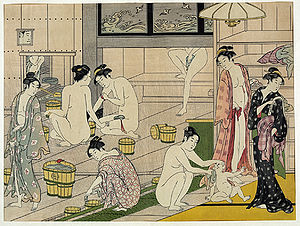
Edo period
The , or , is a division of Japanese history which was ruled by the shoguns of the Tokugawa family, running from 1603 to 1868. The political entity of this period was the Tokugawa shogunate....
(1603–1867), there were two types of baths common to the eastern and western
Kansai
The or the lies in the southern-central region of Japan's main island Honshū. The region includes the prefectures of Mie, Nara, Wakayama, Kyoto, Osaka, Hyōgo, and Shiga. Depending on who makes the distinction, Fukui, Tokushima and even Tottori Prefecture are also included...
regions of Japan respectively. In Edo (present day Tokyo), bath houses contained sizable pools, and were called yuya (湯屋, lit. hot water shop). In Osaka, however, bathing establishments were primarily steam baths called mushiburo (蒸し風呂, lit. steam bath) that had only shallow pools.
At the end of the Edo period, the Tokugawa shogunate
Tokugawa shogunate
The Tokugawa shogunate, also known as the and the , was a feudal regime of Japan established by Tokugawa Ieyasu and ruled by the shoguns of the Tokugawa family. This period is known as the Edo period and gets its name from the capital city, Edo, which is now called Tokyo, after the name was...
(1603–1868) at different times required baths to segregate by sex in order to ensure public moral standards. However, many bath house owners merely partitioned their baths with a small board, allowing some voyeurism to persist. Other baths avoided this problem by having men and women bathe at different times of day, or by catering to one gender exclusively. In spite of this, laws regarding mixed-sex bathing were soon relaxed again.
Contributing to the popularity of public baths in the Edo period were female bathing attendants known as yuna (湯女, lit. hot water women). These attendants helped cleanse customers by scrubbing their backs. After official closing hours, however, a number of these women would perform additional services by selling sex
Prostitution
Prostitution is the act or practice of providing sexual services to another person in return for payment. The person who receives payment for sexual services is called a prostitute and the person who receives such services is known by a multitude of terms, including a "john". Prostitution is one of...
to male customers. Similarly, some brothels in contemporary Japan have women who specialize in bathing with and cleansing male clientele. Such establishments are often called sōpu rando (ソープランド, soapland
Soapland
A ' is a Japanglish and indicates a paradise for men in Japanese. It is said, since in Japan prostitution is officially prohibited by the government, that it is a type of brothel in Japan where male clients can engage in sexual activity with female prostitutes, although officially the clubs do...
).
As a preventive measure against prostitution, the Tokugawa shogunate stipulated that no more than three yuna serve at any given bath house. However, this rule was widely ignored, causing the shogunate to ban female attendants from bath houses altogether and once again prohibit the practice of mixed-sex bathing. Large numbers of unemployed yuna thereafter moved to official red-light districts, where they could continue their services. Up until 1870, there were also male washing assistants called sansuke (三助, lit. three helps) who would wash and massage customers of both genders. Unlike the yuna, these male attendants were not known to engage in prostitution.
Mixed-sex bathing was prohibited once again after Commodore Perry visited Japan in 1853 and 1854—drawing question to the morality of the practice.
Meiji period
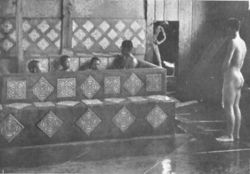
Meiji period
The , also known as the Meiji era, is a Japanese era which extended from September 1868 through July 1912. This period represents the first half of the Empire of Japan.- Meiji Restoration and the emperor :...
(1867–1912) the design of Japanese baths changed considerably. The narrow entrance to the bathing area was widened considerably to a regular-sized sliding door, the bathtubs were sunk partially in the floor so that they could be entered more easily, and the height of the ceiling of the bath house was then doubled. Since the bath now focused on hot water instead of steam, windows could be added, and the bathing area became much brighter. The only difference between these baths and the modern bath was the use of wood for the bathing area and the lack of faucets.
Furthermore, another law for segregated bathing was passed in 1890, allowing only children below the age of 8 to join a parent of the opposite sex.
Rebuilding
At the beginning of the Taishō periodTaisho period
The , or Taishō era, is a period in the history of Japan dating from July 30, 1912 to December 25, 1926, coinciding with the reign of the Taishō Emperor. The health of the new emperor was weak, which prompted the shift in political power from the old oligarchic group of elder statesmen to the Diet...
(1912–1926), tiles gradually replaced wooden floors and walls in new bath houses. On September 1, 1923 the great Kantō earthquake
1923 Great Kanto earthquake
The struck the Kantō plain on the Japanese main island of Honshū at 11:58:44 am JST on September 1, 1923. Varied accounts hold that the duration of the earthquake was between 4 and 10 minutes...
devastated Tokyo
Tokyo
, ; officially , is one of the 47 prefectures of Japan. Tokyo is the capital of Japan, the center of the Greater Tokyo Area, and the largest metropolitan area of Japan. It is the seat of the Japanese government and the Imperial Palace, and the home of the Japanese Imperial Family...
. The earthquake and the subsequent fire destroyed most baths in the Tokyo area. This accelerated the change from wooden baths to tiled baths, as almost all new bath houses were now built in the new style using tiled bathing areas. At the end of the Taishō period, faucets also became more common, and this type of faucet can still be seen today. These faucets were called karan (カラン, after the Dutch word
Dutch language
Dutch is a West Germanic language and the native language of the majority of the population of the Netherlands, Belgium, and Suriname, the three member states of the Dutch Language Union. Most speakers live in the European Union, where it is a first language for about 23 million and a second...
kraan for faucet). There were two faucets, one for hot water and one for cold water, and the customer mixed the water in his bucket according to his personal taste.
Golden era
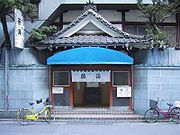
World War II
World War II, or the Second World War , was a global conflict lasting from 1939 to 1945, involving most of the world's nations—including all of the great powers—eventually forming two opposing military alliances: the Allies and the Axis...
(for Japan 1941–1945), many Japanese cities were damaged. Subsequently, most bath houses were destroyed along with the cities. The lack of baths caused the reappearance of communal bathing, and temporary baths were constructed with the available material, often lacking a roof. Furthermore, as most houses were damaged or destroyed, few people had access to a private bath, resulting in a great increase in customers for the bath houses. New buildings in the post war period also often lacked baths or showers, leading to a strong increase in the number of public baths. In 1965 many baths also added showerheads to the faucets in the baths. The number of public baths in Japan peaked around 1970.
Decline
Immediately after World War II, resources were scarce and few homeowners had access to a private bath. Private baths began to be more common around 1970, and most new buildings included a bath and shower unit for every apartment. Easy access to private baths led to a decline in customers for public bath houses, and subsequently the number of bath houses is decreasing. Some Japanese young people today are embarrassedEmbarrassment
Embarrassment is an emotional state of intense discomfort with oneself, experienced upon having a socially unacceptable act or condition witnessed by or revealed to others. Usually some amount of loss of honour or dignity is involved, but how much and the type depends on the embarrassing situation...
to be seen naked, and avoid public baths for this reason. Some Japanese are concerned that without the "skinship" of mutual nakedness, children will not be properly socialized.
Future
While the traditional sentō is in decline, many bath house operators have adjusted to the new taste of the public and are offering a wide variety of experiences. Some bath houses emphasize their tradition, and run traditionally-designed bath houses to appeal to clientele seeking the lost Japan. These bath houses are also often located in scenic areas and may include an open-air bath. Some also try drilling in order to gain access to a hot spring, turning a regular bath house into a more prestigious onsenOnsen
An is a term for hot springs in the Japanese language, though the term is often used to describe the bathing facilities and inns around the hot springs. As a volcanically active country, Japan has thousands of onsen scattered along its length and breadth...
.
Other bath houses with less pristine buildings or settings change into so called super sentō and try to offer a wider variety of services beyond the standard two or three bathtubs. They may include a variety of sauna
Sauna
A sauna is a small room or house designed as a place to experience dry or wet heat sessions, or an establishment with one or more of these and auxiliary facilities....
s, reintroduce steam baths, include jacuzzi
Jacuzzi
Jacuzzi is a company that produces whirlpool bathtubs and spas. Its first product was a bath with massaging jets. The term "jacuzzi" is now often used generically to refer to any bathtub with massaging jets.-History:...
s, and may even have a water slide. They may also offer services beyond mere cleansing, and turn into a spa
Day spa
A day spa is a business establishment which people visit for professionally administered personal care treatments such as massages and facials. It is similar to a beauty salon in that it is only visited for the duration of the treatment. Day spas sited in airport terminals are often called airport...
, offering medical baths, massages, mud bath
Mud bath
A mud bath is a bath of mud, commonly from areas where hot spring water can combine with volcanic ash. Mud baths have existed for thousands of years, and can be found now in high-end spas in many countries of the world....
s, fitness centers, etc., as for example the Spa LaQua at the Tokyo Dome City
Tokyo Dome City
Tokyo Dome City is an entertainment complex in Bunkyo, Tokyo, Japan.It includes the world's largest roofed baseball stadium known as Tokyo Dome , an amusement park known as Tokyo Dome City Attractions , and Korakuen Hall...
entertainment complex. There are also entire bath house theme parks, including restaurants, karaoke
Karaoke
is a form of interactive entertainment or video game in which amateur singers sing along with recorded music using a microphone and public address system. The music is typically a well-known pop song minus the lead vocal. Lyrics are usually displayed on a video screen, along with a moving symbol,...
, and other entertainment, as for example the Ōedo Onsen Monogatari (大江戸温泉物語, Big Edo Hot Spring Story) in Odaiba
Odaiba
is a large artificial island in Tokyo Bay, Japan, across the Rainbow Bridge from central Tokyo. It was initially built for defensive purposes in the 1850s, dramatically expanded during the late 20th century as a seaport district, and has developed since the 1990s as a major commercial, residential...
, Tokyo. (Note: The Ōedo Onsen Monogatari is not a sentō.) Some of these modern facilities may require the use of swimsuit
Swimsuit
A swimsuit, bathing suit, or swimming costume is an item of clothing designed to be worn by men, women or children while they are engaging in a water-based activity or water sports, such as swimming, water polo, diving, surfing, water skiing, or during activities in the sun, such as sun bathing.A...
s and are similar to a water park
Water park
A waterpark is an amusement park that features waterplay areas, such as water slides, splash pads, spraygrounds , lazy rivers, or other recreational bathing, swimming, and barefooting environments...
.
See also
- FuroFurois a Japanese word for bath. Specifically it is used to refer to a type of bath which originated as a short, steep-sided wooden bathtub. Baths of this type are found all over Japan in houses, apartments and traditional Japanese inns but are now usually made out of a plastic or stainless steel.A...
- Hot springHot springA hot spring is a spring that is produced by the emergence of geothermally heated groundwater from the Earth's crust. There are geothermal hot springs in many locations all over the crust of the earth.-Definitions:...
- JjimjilbangJjimjilbangA Jjimjilbang is a large, gender-segregated public bathhouse in Korea, furnished with hot tubs, showers, Finnish-style saunas, and massage tables, similar to a Korean sauna or mogyoktang. Jjimjil is derived from the words meaning heated bath...
- Mikveh
- OnsenOnsenAn is a term for hot springs in the Japanese language, though the term is often used to describe the bathing facilities and inns around the hot springs. As a volcanically active country, Japan has thousands of onsen scattered along its length and breadth...
- Taiwanese hot springsTaiwanese hot springsTaiwan is part of the collision zone between the Yangtze Plate and Philippine Sea Plate. Eastern and southern Taiwan are the northern end of the Philippine Mobile Belt....
Further reading
- Aaland, Mikkel. Sweat: The Illustrated History and Description of the Finnish Sauna, Russian Bania, Islamic Hammam, Japanese Mushi-Buro, Mexican Temescal, and American Indian & Eskimo Sweat Lodge. Santa Barbara, Calif.: Capra Press, 1978. ISBN 0884961249. (Reprint) San Bernardino, Calif.: Borgo Press, 1989. ISBN 0809540231.
- Brue, Alexia. Cathedrals of the Flesh: In Search of the Perfect Bath. New York: Bloomsbury USA, 2003. ISBN 1582341168.
- Clark, Scott. Japan, a View from the Bath. Honolulu: University of Hawaii Press, 1994. ISBN 0824816579.
- Koren, Leonard. How to Take a Japanese Bath. Berkeley, Calif.: Stone Bridge Press, 1992. ISBN 0962813796.
- Smith, Bruce, and Yoshiko Yamamoto. The Japanese Bath. Layton, Utah: Gibbs Smith, Publisher, 2001. ISBN 158685027X.
- Talmadge, Eric. Getting Wet: Adventures in the Japanese Bath. Tokyo; New York: Kodansha International, 2006. ISBN 4770030207.
External links
- www.OnsenJapan.net Interactive Google map of Japanese baths with easy-to-read icons, pictures, and reviews

